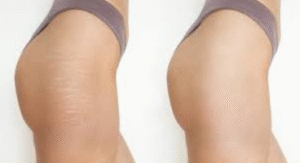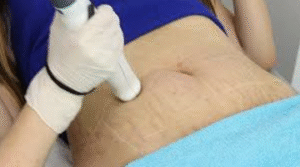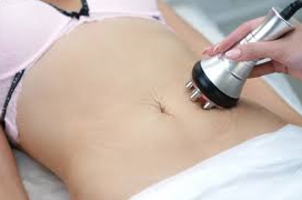Have you ever caught yourself avoiding certain clothes because of those silvery or purplish lines on your thighs and hips? You’re not alone. Stretch marks on thighs and hips affect people of all genders, sizes, and ages. They’re incredibly common yet often a source of insecurity for many.
The good news? There are effective ways to treat stretch marks on thighs and hips, minimize their appearance, and reclaim your confidence. We’ll explore everything you need to know about stretch marks on thighs and hips – from why they form to the most effective treatments and prevention strategies.
Whether your stretch marks are new or have been with you for years, this article will equip you with practical knowledge and solutions.

Understanding Stretch Marks on Thighs and Hips
Stretch marks, or striae distensae, which is a type of scarring develops when the skin rapidly stretches or shrinks. Your skin’s collagen and elastin break down as a result of these alterations and stretch marks could show up when the skin recovers.
They typically start as reddish or purplish lines that eventually fade to a silvery or white color. The thighs and hips are particularly prone to stretch marks due to several factors:
Rapid Growth
Growth spurts during puberty can cause stretch marks on thighs and hips as the body rapidly changes.
Weight Fluctuations
Gaining or losing significant weight in a short period can stress the skin in these areas.
Pregnancy
Hormonal changes combined with the growing uterus can lead to stretch marks on hips and upper thighs.
Genetics
Some people are simply more predisposed to developing stretch marks on thighs and hips due to their genetic makeup and skin type.
Hormonal Changes
Increases in cortisol levels can reduce the skin’s elasticity, making it more susceptible to stretch marks.
Types of Stretch Marks on Thighs and Hips
Not all stretch marks are created equal. Understanding the type you have can help determine the most effective treatment approach:
Fresh Stretch Marks (striae rubrae)
These appear as red, purple, or pink lines and are recent formations. Fresh stretch marks on thighs and hips are more responsive to treatment as the skin is actively trying to heal.
Mature Stretch Marks (striae albae)
These stretch marks are older and have turned silver or white over time. They’re more challenging to treat but not impossible.
Pregnancy-Related Stretch Marks
Often appearing on the hips and upper thighs, these can be influenced by hormonal factors specific to pregnancy.
Adolescent Stretch Marks
Common during gr owth spurts, these typically appear on outer thighs and hips during puberty.
Effective Treatments for Stretch Marks on Thighs and Hips
Let’s explore the wide range of treatments available for addressing stretch marks on thighs and hips, from at-home remedies to professional procedures:
At-Home Treatments
Topical Treatments and Creams
Your first line of defense against stretch marks on thighs and hips often comes in the form of specially formulated creams and oils:
Retinoid Creams
Prescription-strength retinoids like tretinoin can help rebuild collagen and may reduce the appearance of newer stretch marks on thighs and hips. They function by promoting the synthesis of new collagen and quickening cell turnover.
Hyaluronic Acid Products
These helps maintain skin hydration and elasticity, potentially preventing new stretch marks from forming while improving the appearance of existing ones.
Vitamin E Oil
A powerful antioxidant that may help improve skin elasticity and reduce the visibility of stretch marks when massaged into affected areas regularly.
Cocoa Butter and Shea Butter
These natural moisturizers can improve skin elasticity and hydration, potentially minimizing the appearance of stretch marks over time.
Centella Asiatica Extracts
Found in products like Centella creams or ‘tiger grass’ formulations, this herb has been shown to stimulate collagen production and improve skin elasticity.
DIY Natural Remedies
Some people find success with natural approaches to treating stretch marks on thighs and hips:
 Aloe Vera
Aloe Vera
The cooling gel from this plant contains enzymes and nutrients that may help heal and fade stretch marks while soothing irritated skin.
Sugar Scrubs
Regular gentle exfoliation with sugar scrubs can improve blood circulation and remove dead skin cells, potentially helping to reduce the appearance of stretch marks.
Coconut Oil
Rich in medium-chain fatty acids, coconut oil penetrates deeply into the skin to boost hydration and may help prevent and reduce stretch marks when applied consistently.
Olive Oil
Packed with antioxidants and vitamin E, olive oil may help improve skin elasticity and gradually fade stretch marks when massaged into affected areas.
Dry Brushing
This technique increases blood flow to the skin and helps with lymphatic drainage, potentially reducing the appearance of stretch marks on thighs and hips over time.
Professional Treatments for Stretch Marks on Thighs and Hips
For more significant results, especially with mature stretch marks on thighs and hips, professional treatments offer advanced solutions:
Laser Therapy Options
Fractional Laser Treatment:
As a result, the skin develops thousands of tiny treatment zones that promote the synthesis of new collagen. It works especially well for white stretch marks on the hips and thighs.

Pulsed Dye Laser:
Ideal for newer, red stretch marks, this treatment targets blood vessels in the marks, reducing redness and potentially improving texture.
Intense Pulsed Light (IPL):
This technology uses multiple wavelengths of light to treat various skin concerns, including stretch marks on thighs and hips.
Other Clinical Procedures
Microdermabrasion:
This exfoliating treatment removes the outermost layer of skin, potentially reducing the appearance of stretch marks on thighs and hips while stimulating collagen production.
Microneedling:
Tiny needles create controlled micro-injuries in the skin, triggering natural healing processes and collagen formation that can improve stretch marks’ appearance.
Chemical Peels:
By removing outer layers of skin, chemical peels can reduce the appearance of stretch marks and stimulate new skin growth.
Radiofrequency Treatments:
These use heat energy to stimulate collagen and elastin production, potentially tightening skin and improving stretch marks on thighs and hips.
PRP (Platelet-Rich Plasma) Therapy:
This treatment uses your own blood plasma, rich in growth factors, to stimulate skin repair and regeneration when injected into stretch mark areas.
Prevention Strategies for Stretch Marks on Thighs and Hips
Preventing stretch marks is often easier than treating them after they’ve formed. Here are practical techniques to help your skin maintain resilience:
Maintain Stable Weight:
Avoid rapid weight gain or loss, as these fluctuations can stress the skin and lead to stretch marks on thighs and hips.
Stay Hydrated:
Skin that has been properly moisturized is more elastic and less likely to tear. Drink at least eight glasses of water each day to keep your skin hydrated and healthy.
Balanced Diet:
Consume foods rich in:
- Vitamin C (supports collagen production)
- Vitamin D (helps skin health)
- Vitamin E (powerful antioxidant for skin)
- Zinc (helps growth and skin healing)
- Protein (essential for skin repair)
Regular Exercise:
Keeping muscles toned can help support skin structure and potentially reduce the likelihood of developing stretch marks on thighs and hips.
Early Intervention:
Address stretch marks as soon as they appear for best results, as fresh stretch marks respond better to treatment than older ones.

Lifestyle Factors That Affect Hip and Thigh Stretch Marks
Your daily habits can significantly influence the development and appearance of stretch marks:
Smoking:
Cigarettes restrict blood flow and damage collagen and elastin, making skin more susceptible to stretch marks and impairing healing.
Sun Exposure:
While sun won’t cause stretch marks, it can make them more noticeable by darkening surrounding skin while the marks themselves don’t tan.
Stress Management:
High stress levels increase cortisol production, which can affect skin elasticity and potentially worsen stretch marks on thighs and hips.
Sleep Quality:
During deep sleep, your body repairs skin tissues and produces growth hormone, which supports skin health and elasticity.
Clothing Choices:
Very tight clothing that restricts movement can potentially stress skin in vulnerable areas like thighs and hips.
The Effects of Stretch Marks on Your Mind
Beyond the physical aspects, it’s important to address the emotional side of having stretch marks on thighs and hips:
Body Positivity:
Remember that stretch marks are incredibly common and a natural part of many bodies. They tell the story of your life’s changes and growth.
Community Support:
Following body-positive social media accounts and connecting with others who embrace their stretch marks can help shift your perspective.
Mental Health:
If stretch marks are causing significant distress, speaking with a mental health professional can provide helpful coping strategies.
Celebrating Progress:
Focus on improvements in skin texture and appearance rather than complete elimination of stretch marks on thighs and hips.
When to Consult a Dermatologist About Hip and Thigh Stretch Marks
While stretch marks are harmless, certain situations warrant professional attention:
- If stretch marks appear without obvious cause
- When they cover unusually large areas
- If they’re accompanied by other concerning skin changes
- When at-home treatments show no improvement after several months
- If stretch marks cause significant emotional distress
A board-certified dermatologist can recommend personalized treatment plans based on your specific situation, skin type, and stretch mark characteristics.
Expectations for Treating Stretch Marks on Thighs and Hips
When treating stretch marks, it’s critical to keep expectations reasonable:
Timeline:
Most treatments require multiple sessions and several months to show significant improvement.
Degree of Improvement:
Complete elimination of stretch marks is rare; most treatments aim for reduction in appearance rather than removal.
Individual Factors:
Your skin type, age of stretch marks, genetic factors, and consistency with treatments all influence results.
Combination Approaches:
Often, the best results come from combining multiple treatment methods, such as topical products with professional procedures.
FAQs
Can hip and thigh stretch marks disappear entirely?
Stretch marks can decrease considerably over time, but they seldom go away entirely. Fresh red or purple stretch marks have the best chance of improvement with early treatment. Professional treatments like laser therapy, microneedling, and chemical peels can dramatically reduce their appearance, while consistent use of topical treatments can help them fade.
Complete elimination is uncommon, but substantial improvement is definitely achievable with the right approach.
What causes stretch marks specifically on inner thighs and hips?
Stretch marks on inner thighs and hips typically develop when skin stretches rapidly due to growth spurts, weight changes, pregnancy, or hormonal shifts. These areas are particularly prone to stretch marks because they store more fat and experience significant expansion during weight gain.
You are more prone to have stretch marks if you have family members who do. Genetics also plays a significant part.
How long does it take to see results when treating stretch marks on thighs?
Seeing noticeable improvements in stretch marks on thighs typically requires patience. With consistent daily use of topical treatments like retinoid creams or vitamin E oil, you may begin to see subtle changes within 6-12 weeks.
Professional treatments often show more dramatic results, but usually require multiple sessions spaced 4-6 weeks apart, with full results appearing after 3-6 months of treatment. Older, white stretch marks take longer to heal than new, red ones.
Are there any permanent solutions for stretch marks on hips?
There is no permanent ‘cure’ for stretch marks on hips, but certain treatments can create long-lasting improvement. Professional procedures like fractional laser therapy, deep microneedling, and radiofrequency treatments stimulate collagen remodeling that creates permanent changes in skin texture and appearance.
While results are long-lasting, they won’t prevent new stretch marks from forming if skin stretches rapidly again in the future. Maintaining stable weight and continuing skin care routines helps preserve improvements.
Do natural remedies really work for stretch marks on thighs and hips?
Natural remedies can help improve the appearance of stretch marks on thighs and hips, particularly when used consistently and started early. Ingredients like centella asiatica (tiger grass), cocoa butter, and oils rich in vitamin E provide hydration and support skin’s natural healing processes.
However, their effects are typically modest compared to professional treatments or prescription retinoids. Natural approaches work best for prevention and for enhancing results from other treatments.
Conclusion…
Dealing with stretch marks on thighs and hips is a personal journey that requires patience and consistency. Whether you choose to treat them actively or embrace them as part of your body’s unique story, understanding your options empowers you to make informed decisions.
With consistent care and the right approach for your specific situation, you can improve the appearance of stretch marks on thighs and hips and feel more confident in your skin.



